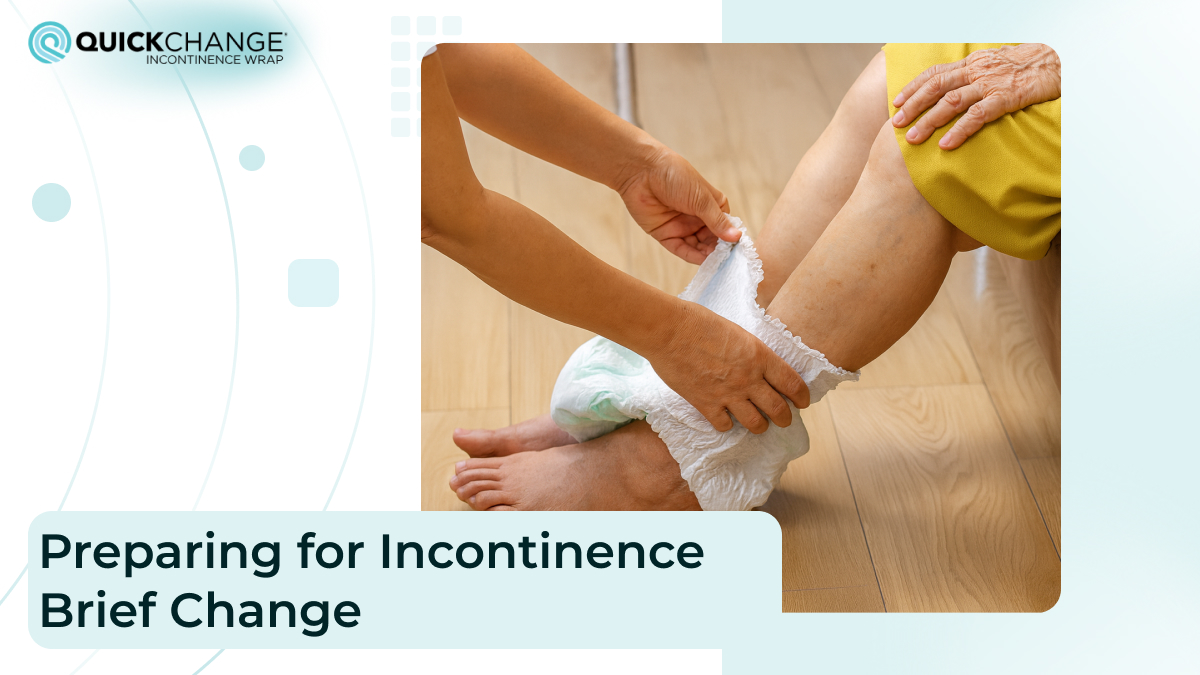Changing an Adult Diaper/Incontinence Brief of Uncooperative Patients

A prevalent condition that many people encounter as they age is incontinence. It becomes especially difficult to deal with, as some people might not have the ability to assist their caregivers in taking care of this problem. Nevertheless, they still need to follow through with all the procedures to prevent infections and rashes. This is where incontinence pads and briefs come in handy.
You may need to assist a loved one who is incontinent and has limited mobility in changing their incontinence pads or briefs. At first, changing incontinence briefs may seem daunting and awkward, but it becomes much simpler once you know how to do it. To help you with this challenging task, we prepared a simple instruction and tips on how to do it comfortably and safely for everyone.
Understanding the Challenge of Adult Diaper Change
Changing an incontinence brief in an uncooperative male patient can be challenging. Several reasons frequently contribute to this issue:
- Pain. Discomfort might be extensive or radiate from different areas, making it difficult to identify and diagnose.
- Fear and anxiety. These feelings can exacerbate resistance to care, particularly when patients do not completely comprehend the need for intervention.
- Cognitive impairment. Dementia-related behaviors like agitation, disorientation, or violence can exacerbate the situation.
Because of these problems, incontinence care must always prioritize safety and dignity. Caregivers can alleviate distress and promote cooperation by employing tactics that foster trust, lessen discomfort, and respect the patient's requirements.

Preparing for Incontinence Brief Change
Being both compassionate and practical is crucial while providing care for a person who has incontinence. Such a condition can cause embarrassment as well as stress. Your acceptance and reassurance can help your loved one or a patient feel more at ease.
1. Use language that preserves dignity
Even if the term “adult diaper” is totally normal and widely accepted among medical workers, it might cause unnecessary negative emotions in the one in your care. We advise using milder terms like briefs. To avoid unnecessary embarrassment, approach the assignment with a practical mindset, as you may find yourself in a similar situation one day.
2. Privacy
Maintain a warm and private space to ensure both comfort and dignity are safeguarded. When changing incontinence briefs, ensure your loved one's privacy by keeping others out of the room and closing doors or curtains.
3. Supplies
Before changing an incontinence brief, assemble the following supplies: gloves, wipes, a new brief, barrier cream, a turn sheet, and a trash bag. Having everything within reach reduces disruptions, allowing the patient to feel safer and at ease. A barrier cream can assist in preventing skin breakdown, while a turn sheet promotes safe repositioning and reduces caregiver strain.
4. Calm attitude
Maintain a quiet, comforting tone during the procedure, describing each step before touching the patient, even if they have dementia, as familiarity can help minimize anxiety and resistance. Use basic, plain language and allow the patient time to digest each activity.
These tiny, targeted efforts make the patient and caregiver's experience safer and more courteous, increasing cooperation and lowering the chance of damage or discomfort.
Managing Pain Before Changing an Incontinence Brief
Recognizing and controlling discomfort is critical before changing an incontinence brief for elderly patients, particularly those with cognitive limitations.
Signs of pain:
- Facial expressions such as grimacing
- Vocalizations like moaning or saying "ouch"
- Stiff or rigid limbs
- Verbal complaints of discomfort
The PAINAD scale, which ranges from 1 (moderate pain) to 10 (severe pain), can assist patients with advanced dementia in evaluating pain based on observable behaviors.
Pain management techniques:
- For suitable pain relief, such as acetaminophen or prescription drugs, speak with a healthcare professional.
- To give medication time to work, administer it 30 to 45 minutes before treatment.
- For older persons with mild-to-moderate pain, acetaminophen should be used as the first line of treatment.
- During the quick change, place the patient in a comfortable position and proceed slowly and gently.
Caregivers can enhance patient comfort, promote collaboration, and offer a safer, more respectful care experience by proactively managing pain.
How to Change an Adult Diaper in Bed Without Distress
Resistance to incontinence assistance and care is frequent and might originate from anxiety, fear of falling, or a loss of control. Confusion and agitation are especially common in dementia patients—research indicates that approximately 30% of dementia patients have agitation, which complicates caregiving.
Besides dementia, several patient categories can be uncooperative during incontinence care:
- Painful conditions, such as arthritis, urinary tract infections, or post-surgical discomfort, often make movements distressing.
- Anxiety or fear, including fear of falling or exposure, can lead to resistance. - Cognitive impairments like delirium, traumatic brain injury, or developmental disabilities may limit understanding.
- Psychiatric disorders, such as severe depression, psychosis, or agitation from bipolar disorder, can interfere with cooperation.
- Communication challenges, including aphasia, hearing loss, or language barriers, may cause misunderstandings.
Even children or adolescents with behavioral disorders, such as autism or ADHD, may resist care.
Strategies to Reduce Distress During Adult Diaper Change
To increase cooperation and comfort, caregivers should follow simple rules:
- Speak calmly, use slow, soft movements, and explain each step before proceeding.
- Remind dementia sufferers to repeat familiar phrases and offer regular reassurance.
- Avoid sudden movements.
- Create a tranquil setting with soft lighting and low background noise.
- If agitation becomes severe, a healthcare provider may provide lorazepam or haloperidol. These can help with acute behaviors, but they should be used with caution owing to the possibility of negative effects.
By combining these strategies, caregivers can improve cooperation, safety, and dignity during incontinence care.
Remember that each case requires patience, reassurance, and tailored strategies to ensure safety and dignity.
Step-by-Step Guide to Changing the Disposable Incontinence Briefs
Incontinence briefs should be changed as soon as they become moist or soiled. When this occurs, inform the person in your care that you will assist them in changing their briefs. Then follow through with the diaper changing procedure for a bedridden patient. Here’s a full instruction that will help you to do it easily.
Step 1: Prepare and Protect
Wash your hands thoroughly. Put on disposable gloves. Gather supplies:
- clean briefs;
- wipes;
- barrier cream;
- a turn sheet;
- a new incontinence pad;
- a trash bag or diaper pail.
Step 2: Position the Patient
While the patient is lying on their back, undo the tabs of the soiled brief. Gently roll the patient onto one side using a turn sheet, guiding at the hips. Slightly bend their legs at the knee to maintain balance.
Step 3: Remove the Soiled Brief
Grasp the top of the brief, roll it inward, and tuck any mess inside as you pull it away from the body. Roll up the soiled brief and dispose of it in the trash bag or diaper pail.
Step 4: Clean the Front Area
Use wet wipes to gently clean the perineal area from front to back to prevent infection. Be sure to clean all skin folds. Gently pat the skin dry.
Step 5: Clean the Back Area
Roll the patient onto the other side. Clean and dry the buttocks and the surrounding area. Allow skin to air dry for a few moments before proceeding.
Step 6: Protect the Skin
Change into fresh gloves if needed. Apply a thin layer of barrier cream to protect against irritation and incontinence-associated dermatitis. Note any rashes, redness, or broken skin, and report these to a nurse or physician.
Step 7: Prepare the Bed and Brief
While the patient is on their side, straighten blankets and place a clean incontinence pad under them if required. Slide a clean brief under the patient's hips, making sure it is smooth and properly positioned.
Step 8: Apply the New Brief
Roll the patient gently back onto their back. Pull the clean brief between the legs. Fasten the tabs securely:
- Top tabs should face downward.
- Bottom tabs should face upward.
Adjust the brief so it fits snugly but comfortably without pinching the skin.
Step 9: Finish Up
Reposition and cover the patient with linens. Remove and dispose of gloves properly. Wash your hands thoroughly.
Important: When changing incontinence briefs, don’t forget that it's critical to keep safe not only the person you’re helping to change but also yourself. Always wear gloves, change them during the process if needed, and wash your hands afterward.
Incontinence Brief Change Aftercare
Skin protection and infection prevention are the key points of a thorough aftercare procedure that follows the adult diaper change. While we’ve already touched on some points of this procedure in the step-by-step guide, let’s look more into its peculiarities and importance. So, here are some more detailed instructions on post-incontinence brief change care.
1. Hand Hygiene
Wash your hands thoroughly before and after care to prevent the spread of bacteria.
2. Patient Safety and Comfort
Check for the resident's comfort and ask if anything else is needed. Ensure the bed is in the lowest position and the brakes are locked. Place the call light or signaling device within reach. Open the door and privacy curtain when finished.
3. Skin Inspection and Protection
Inspect the skin for any redness, rash, or open sores. Apply a thin layer of zinc oxide or dimethicone barrier cream to protect against moisture damage. Replace soiled briefs promptly to lower the risk of incontinence-associated dermatitis, which can develop quickly if the skin stays wet.
4. Documentation and Reporting
Some health conditions might require documenting the output from the soiled brief. Report any skin issues or changes to the nurse or healthcare provider.
QuickChange Wrap as a Top Alternative to Incontinence Briefs
The QuickChange Wrap enables caregivers to change a dirty brief without repositioning the patient, making it especially useful for patients who are uncooperative or bed-bound. This wrap can be applied in less than 30 seconds, considerably decreasing handling and disruption. You can see how easy it is to manage changing patients with this solution by following simple instructions.
The minimum handling involved reduces patient suffering and caregiver burden. For people with dementia or cognitive impairment, a faster transition process can reduce confusion, agitation, and distress.
Overall, the QuickChange Wrap offers a major advantage by allowing a faster, less intrusive change, reducing agitation, discomfort, and physical strain. QuickChange also protects skin integrity and promotes dignity, making it a practical and compassionate choice for both professional and at-home care.
Conclusion
Changing an incontinence brief for an uncooperative patient can be challenging, but it becomes more manageable with preparation, empathy, and the right tools. Addressing pain, anxiety, and fear before beginning helps improve cooperation. Gentle handling and respectful communication preserve dignity, while safe techniques protect both patient and caregiver. Consistent aftercare ensures skin health and supports comfort, safety, and quality of life.
With QuickChange Wrap, you can handle all these important steps and procedures with more ease while maintaining the efficiency of male incontinence assistance. For those seeking support, we invite you to purchase a 10 Count Trial Pack or request a Professional-Use Sample Pack for healthcare institutions.
FAQ
- How often to change incontinence briefs?
Change a person's incontinence briefs four to six times per day. It is recommended that people with moderate incontinence change their diapers every two to four hours. Those with slight bladder control issues may just require a fresh diaper every four to six hours. Generally speaking, you should check the incontinence brief at least once every two hours to see if it’s dirty. For comfort and skin protection, it is crucial to replace it as soon as it gets dirty.
- How quickly should you be able to change an adult diaper?
It should take you less than three minutes to finish the process. In the end, it relies on a number of variables, including the patient's size, cooperation level, and whether you have another certified nursing assistant to assist you. If you need an even faster solution, opt for QuickChange. To change our incontinence wrap, you’ll be able to do it in less time thanks to an easier mechanism.
This content is for informational purposes only and is not intended as a substitute for professional medical advice, diagnosis, or treatment. Always seek the advice of your physician or other qualified health provider with any questions you may have regarding a medical condition. Never disregard professional medical advice or delay seeking it because of something you have read or seen here.

